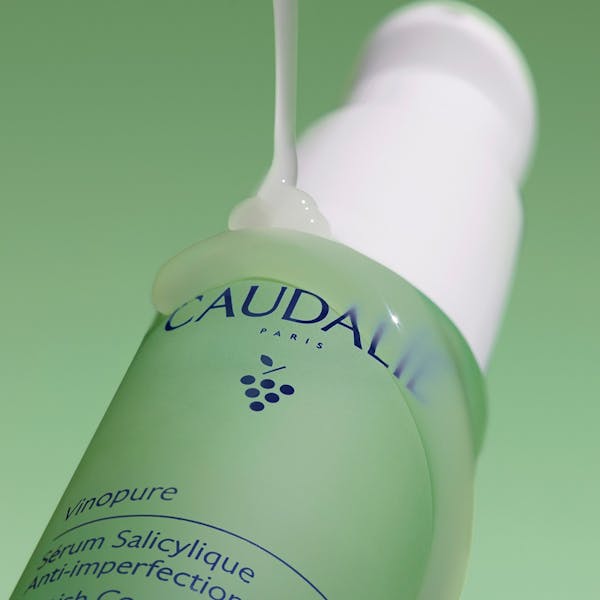Spots around the mouth are a common skin concern that can appear for various reasons, from hormonal changes to lifestyle habits. Understanding their causes and triggers is the first step to treating them effectively and preventing future breakouts
Summary
What are spots around the mouth?
How to identify them?
Spots around the mouth can look and feel different from other breakouts. They often appear as red bumps, sometimes filled with fluid, and can cause discomfort or itching. Unlike blackheads or whiteheads, they tend to be localised to the skin around the lips and chin area.
Are they common?
Spots in this area are relatively common and can affect people of all ages. They may appear occasionally or as part of a recurring skin issue, depending on the underlying cause.
What causes spots around the mouth?
Hormonal imbalances
Hormonal fluctuations, such as surges in androgen levels, can send the sebaceous glands into overdrive, producing excess oil. When this oil mixes with dead skin cells inside pores, pimples can develop.
Acne or perioral dermatitis
Both acne and perioral dermatitis can occur around the mouth, each with its own characteristics. Perioral dermatitis often appears as small, red bumps and may be linked to hormonal changes or a genetic predisposition.
Allergic reactions and irritants
Reactions to certain foods, toothpaste, or skincare products can cause inflammation and make skin more vulnerable to bacteria. Ingredients such as fluorides or strong fragrances can trigger flare-ups.
Poor hygiene or cosmetic products
Impurities on the skin’s surface can allow bacteria to grow, leading to nodules and pimples. Cosmetics that clog pores can have the same effect, so choosing non-comedogenic formulas and keeping the skin clean is important.
Digestive or internal health issues
In some cases, spots around the mouth may be linked to digestive health, nutritional deficiencies, or other internal imbalances. Consulting a healthcare professional can help identify these less obvious causes.
Common symptoms to watch for
Redness and inflammation
Spots in this area can disrupt the skin barrier, leading to visible redness and swelling, sometimes even in areas without active pimples.
Dryness or flaking skin
Inflammation can damage the skin’s protective layer, resulting in dehydration and flaking. This is particularly common in perioral dermatitis.
Painful or itchy bumps
The bumps may be tender to the touch or cause itching. They can be aggravated by certain triggers, such as topical steroids, toothpaste with fluoride, or salty foods.
How to treat spots around the mouth?
Skincare routine adjustments
Adopting a consistent acne- prone skincare product routine can help keep this area clear and reduce the risk of flare-ups. Caudalie’s Vinopure range is formulated with natural-origin, vegan ingredients to help purify the skin while being gentle on its balance.
Gel Facial Cleanser with Salicylic Acid: Cleanses without drying, removing impurities and preparing the skin for further treatment.
Salicylic Acid Toner: Helps refine skin texture and reduce excess shine while keeping pores clear.
Salicylic Acid Serum: Targets blind pimples and imperfections deep within pores and smooths the skin without increasing photosensitivity. It effectively targets all types of imperfections: excess sebum, enlarged pores, blackheads, papules and pustules. Its effectiveness has been clinically proven: 86% of users see a reduction in their spots in just 7 days*.
Mattifying Moisturiser: Keeps skin hydrated yet shine-free all day, enriched with grapeseed extract, B vitamins, and peppermint oil.
Salicylic Spot Solution: Targets emerging spots while soothing irritation, with tea tree oil to help control bacteria. This treatment reduces localised spots in just 4 hours** and can be applied at any time of day.
Over-the-counter or prescription treatments
Depending on the diagnosis, a dermatologist may recommend topical or oral medications. Ingredients like azelaic acid, benzoyl peroxide, or prescription retinoids can help manage persistent breakouts.
When to see a dermatologist
If spots do not improve with over-the-counter care, cause significant discomfort, or lead to scarring, it’s advisable to consult a dermatologist for tailored treatment.
Spots around the mouth can be frustrating, but identifying their causes and adopting the right skincare and lifestyle habits makes a real difference. With consistent care and preventive measures, it’s possible to reduce breakouts and restore clearer, healthier-looking skin.
*Clinical study, % of satisfaction, 43 volunteers
**Clinical study, self-scoring, 22 volunteers, 28 days
LATEST BEAUTY NEWS
- Personal data & Cookies
- T&C
- Legal Note
- Loyalty Program
- MYCAUDALIE terms
© Caudalie Copyright









